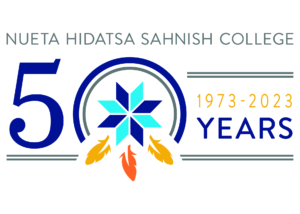Student Learning Assessment.
SUMMARY OF ASSESSMENT PLAN AT NUETA HIDATSA SAHNISH COLLEGE
Assessment of Student Learning at Nueta Hidatsa Sahnish College is designed to ensure that each segment of the College contributes in a positive way to the student’s learning experience. Nueta Hidatsa Sahnish College faculty and staff believe that:
- Continual assessment and feedback produces an academic environment that enables each student to progress toward his or her potential
- Nurturing students’ human potential is vital to the well-being of the MHA Nation
Assessment supports the goal of producing students who can successfully continue their formal education at transfer institutions, or who are able to excel in their chosen career fields. Assessment also ensures the accountability of the college; validation of student learning likewise validates the expenditure of resources required to provide educational services.
Student Learning Assessment is performed on several levels:
- Institutional
- General Education
- Program
- Faculty
- Course
At the institutional level, students should internalize the Earth Lodge Model. They should also master the four Institutional Core Competencies of Constructivism, Culture, Technology, and Information Literacy.
Specific institutional learning objectives are:
- Students will develop critical thinking skills
- Students will be able to clearly communicate both orally and in writing
- Students will effectively utilize quantitative reasoning, scientific methods and technology
- Students will acquire intellectual concepts and dispositions that enable them to live and contribute as active and successful tribally educated participants in a diverse and global society
- Students will receive information and training on emotional, mental, physical, social, and spiritual wellness
General education at the Nueta Hidatsa Sahnish College is an integral and important part of the student’s college experience. These general education guidelines should be woven into each program’s outcomes, but the assessment of these outcomes is entirely up to the faculty. General education provides students learning experiences meant to:
- develop abilities to think critically
- clearly communicate – both orally and in writing
- effectively use mathematics, science and technology
- acquire intellectual concepts and dispositions that enable them to live and contribute as active and successful tribally educated participants in a diverse and global society
- serves as a foundation to promote mental, physical and spiritual wellness and lifelong learning.
General Education Learning Outcomes are assessed through the Liberal Arts Capstone Course. Rubrics have been created and implemented to quantify student learning through application of various products or projects.
The following are the General Education Learning Outcomes for Liberal Arts Candidates:
- Students will be able to demonstrate their knowledge of the Mandan, Hidatsa, and Arikara culture.
- Students will be able to explain or demonstrate how humanistic or artistic expressions create or critique culture.
- Students will demonstrate proficiency in skilled listening and effective speaking.
- Students will be able to apply the scientific method to a contemporary issue and communicate his/her interpretations both orally and in writing or formulate and test hypotheses in either laboratory, simulation, or field experiences and communicate his/her experimental findings and interpretations both orally and in writing.
- Students will be able to demonstrate understanding of fundamental concepts and methods within the social sciences.
- Students will be able to demonstrate the use of technology in their scholastic and career endeavors.
- Students will be able to reason quantitatively in order to effectively solve real-world problems and explain mathematical concepts and data both written and orally.
- Students will be able to demonstrate an understanding of the connection between writing and thinking and use writing and reading for inquiry, learning, thinking, and communicating in the an academic setting.
Program (Field of Study)
Program specific outcomes are assessed in each department by the annual Program Review Process utilizing the Program Review Scoring Rubric, and Student Learning Matrix. Specific programs that do not attain the minimum score or are in jeopardy due to extenuating circumstances are required to complete a three-year comprehensive program review.
Programs receiving a rubric score below a cut-off score will be brought before the Assessment Committee where the Program Director will present the plan for improvement or discontinuation for the program. Recommendations from the Assessment Committee will be brought before the Curriculum Committee, Administration Committee, and the Board of Directors.
Faculty
Faculty are formally evaluated each Spring Semester. A completed portfolio for evaluation includes the following: Individual Development Plan (Peer Review), Small Group Instruction Diagnosis (SGID’s), Course Evaluations, Faculty ePortfolios. Administration may schedule visits with the instructor to observe his/her teaching methods. This process is not meant to be punitive. Administrators will provide feedback in a constructive manner.
Course
Learning in each course is assessed through various methods including: course evaluations, Small Group Instruction Diagnosis (SGID’s), rubrics applied to student work, student grades, and the percentage of students completing the course. Students are required to complete course evaluations at the end of each semester. These evaluations are tabulated, and the results are used to formally evaluate the instruction.
